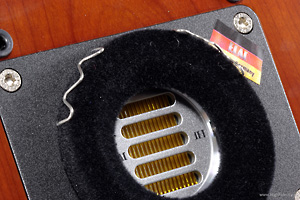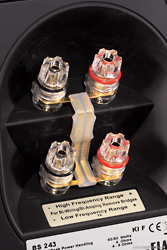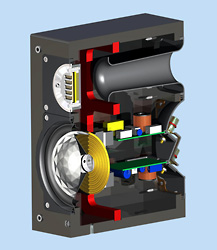The German company ELAC celebrates 100 years in business this year (2008). It was not called like that from the very beginning and was not doing the same it does now (it started from research of submarine devices, including echolocation, that was developed during the years of the second World War; this was hi-tech technology, real rocket science), but the company page quotes that year as the begin of ELAC’s history. In reality, the first company dealing with sound, named Electroacoustics was founded in 1926, and the name ELAC appears first in 1948 with a new series of turntables. The model BS 243, tested this month, is a small loudspeaker for relatively low money, but equipped in two main developments of the company: their version of the AMT dr Heil transducer named JET and the most recent version of the mid-woofer with a diaphragm made from an aluminum-paper sandwich, but without a smooth surface. It is diamond shaped, what is meant to improve the rigidity of the piston and the liquidation of the parasite vibration (and among others the Doppler Effect). Such doings are common and used since years, but until recently those were done using membranes from glass fibers, carbon fibers or Kevlar. Also Scan-Speak used their solution – the famous “cut” paper diaphragms. But ELAC went one step further, and similar to Monitor Audio shaped a diaphragm made from homogenous material.
Although the loudspeakers BS 243, from the newest series in the catalog – ‘240’, are ones of the smallest loudspeakers I dealt with, still there are smaller loudspeakers with the JET driver – the 310.2 JET. The driver was introduced in 1993 and became ELAC’s most important patent. Let’s add, that the company measured itself against the tweeter domes since long. Already in 1987 one of the best dome tweeters of the company came to life, the 25mm model HT 25 KST III, where the aluminum dome was made from one piece of metal together with the voice coil carcass, what guaranteed splendid rigidity and bettered heat transfer. But this tweeter was not what could fully satisfy ELAC engineers. Now in all but the cheapest ‘50’ series, where we see still a traditional dome, the JET tweeter is being used. This German company is also known from one more design: an omnipolar supertweeter (transferring up to 50kHz) 4Pi II, available as a separate element, that we can use to enhance any standard loudspeaker. SOUND The ELAC are small loudspeakers – and I mentioned that – are ones of the smallest I tested. So we should mark in the very beginning, that some aspects of the sound, known from bigger speakers, are not available. And that’s it. The German loudspeakers, complete with the cabinet, wire terminals and all, would fit inside the cross-over chamber of my Harpia Dobermann... So it was very hard, having so small transducers and cabinet, and also so little – as for the finish and sound – money, to prepare a sound that would be a solid and complete proposition for an audiophile. And the BS 243 proposes exactly that, its own, very attractive vision of the world and the recordings. I do not know if I am right, but the company owes the success to a great extent to the tweeter. Because this one presents most of the assets, that are available in the more expensive constructions using this speaker, also coming from other companies. Of course – this driver does not work in a void, and influence on its perception is also coming from the classic piston-type mid-woofer (classic in a way of speech, here it has a specially shaped diaphragm, but I just mean a dynamic driver) and the elements of the cross-over, internal cabling, etc.
And still the German loudspeakers in question keep that, what makes the AMT and the ribbons – planar speakers in general – such an attractive alternative to classic drivers. I am thinking about the total lack of brightening and harshness. There are no sharp edges with those transducers. I am thinking about distortion that we perceive as harshness, but it must be said, that the attack in those speakers in not fully drawn like in the dome type drivers, and to what – and probably most of you – got used. The treble in the BS 243 is silky, slightly back in comparison to the midrange and the bass and has an absolutely coherent character. When I talk about the lack of harshness I mean a complete change of perspective – instead of an “s” in sibilants, if they are underlined on a disc, we have something between an “s” and “sh” (please try to pronounce something like this, and then a clean “s” and you will know what I mean). We get dense cymbals, with a splendidly differentiated structure – cymbals that have no clear ‘hit’, this moment they are hit, that is there in reality. This is the same with other instruments, like a vibraphone. Because I like jazz performed by Milt Jackson or Terry Gibbs, I listen often to that type of music. The ELAC splendidly showed the filling, the depth of the separate hits, regardless if this was on the disc Pyramid The Modern Jazz Quartet (Atlantic/Warner Music Japan,WPCR-25125, CD) or A Jazz Band Ball (Mode/Muzak, MZCS-1172, CD), the vibraphone was shown in a deep, full way. It was the same with the saxophone of the Art Pepper disc …the way it was! (Contemporary Records/Mobile Fidelity, UDSACD 2034, SACD/CD). "The ELAC, despite their character, have a really refined treble due to the JET driver." The stage is not bad in those speakers – coming quite deep and wide, although the volume of the sounds, their dimensions are not so big. Those are small speakers, and they should be treated as such. The instruments have an individual space around them, just drawn without any emphasis, like from expensive speakers. The space itself, the response of the room, is not very clear. Here the size and the price of the product are the limiting factors. This cannot be overcome. But we should listen to the BS, because they will excel in the places where we do not have much room, but do not want to sacrifice the sound too much. If we do not play too loud, and use nice electronics, then everything will sound nice – from jazz to rock. Because I listened through the ELAC to many discs of that last kind - Peter Gabriel from Security (Geffen/Warner Bros., 2011-2, CD), King Crimson from Thrak (Discipline Global/Virgin, 8 40313 2, CD) sounded very impressive and nice. Even nicer sounded the recently acquired by me, Japanese version of the disc Time Electric Light Orchestra (Epic/Sony Music Direct (Japan), MHCP 1161, CD). I own is as the original lp, as well as the last, “regular”, European re-master. The latter cannot be listened to, unfortunately. Anyway, the ELO sounded from the ELAC in an energetic, full way – just like from the vinyl.
The loudspeakers warm slightly the transmission, mostly by eliminating the harshness and sanding from the sound, and only in the second place from the stronger upper bass. The level of the treble could have been higher, we would get more assets of the AMT transducer, but I understand this choice: with this budget for electronics all its flaws would be highlighted. Maybe without annoying brightness, but still… So this may be a good compromise. I mentioned about a small room for the Elacs. If they are to work there, then it might be worth to close the bass-reflex port with the external ring of the foam plug that is supplied with the speakers. The whole plug makes the sound too light and losing dynamics. There is also an option of the JET DC – a soft ring, mounted in front of the tweeter by means of four wire elements. It is designed to kill off the higher part of the spectrum, that normally goes to the edges of the front baffle, where the waves bend and interfere with each other introducing distortion to the sound. This is theory. And the practice? At the first moment placing the rings causes no effect, except lowering the treble level. But when I dismounted this contraption, it turned out, that there is a change, not big and may be neglected, but noticeable. And it is heard as ennobling of the attack (with the JET DC on) and its better lighting. And this is a step in the right direction. The cymbals get a bit out of the background, and here this is important. But those rings are not obligatory for me, especially as they make the loudspeakers look worse. DESCRIPTION
The Model 243 of the German company ELAC is the smallest speaker of the new ‘240’ series. It is a two-way speaker in a bass-reflex cabinet. The treble is handled by a JET type speaker – this is a version of the AMT transducer (Air Motion Transformer), that functions based on the principle, that instead of a diaphragm working as a piston, we have a folded sheet that we can compress and extend, what expels air from the folds at high speed. The model mounted in the ELAC (JET III c) is not very big – the loudspeakers from Oskar Heil (eg. the known model Kithara), as well as the transducer used in Mark&Daniel products has a significantly larger surface. The JET is powered by neodymium magnets and is enclosed in a metal box damping the energy from the back of the membrane. Below we see a mid-woofer, with 150mm diameter, with a diaphragm made in the form of a sandwich: on a paper base a diamond or crystal shaped surface aluminum element is glued. Hence the name: Crystal Membrane. Its spider is pressed from sheet metal and equipped in a double magnet driver. Both drivers have plastic masking elements.
The enclosure is made from MDF and covered by a natural veneer from the outside and the inside (!). This is done also by Totem Acoustic, arguing that this gives the whole a different, and thinkable better, resonance structure. The inside is fully damped with a material, looking like un-pressed felt. The cabinet, while being already rigid by being small, was additionally supplemented with a MDF reinforcement. The cross-over is mounted directly to the wire terminals. To separate the treble and mid-woofer section, the cross-over is mounted on two separate PCBs, each handling the relevant section. In the treble section we find three air coils and a few capacitors, including a polypropylene and polystyrene ones. The circuit looks complicated; there are also some resistors there. For the lower section we see an air coil and a core one, there is also a polypropylene capacitor to be found. The speakers are connected by means of plaid wires – one is copper, one from silver coated copper. The wire terminals are double, gold plated and connected by thin wire crimps. Despite the knurled plastic caps, they are not easy to use, because they were mounted in a plastic mold, too close to the side, so it is difficult to get a good grip on them. The bass-reflex is mounted on the back and can be closed by means of the supplied foam plug. Similar to B&W also ELAC makes them from two elements, so we can close the bass-reflex completely or partially, adjusting the bass from the speaker. The loudspeakers are fantastically made and bear the proud sticker ‘Made in Germany’. Advanced engineering and good looks. This is ELAC. |
©2008-2025 AudioStereo






